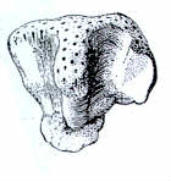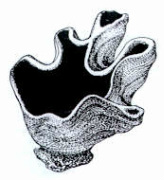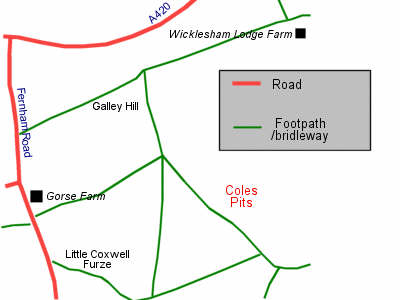Faringdon Sponge Gravels
Faringdon is situated on the Golden or Corallian Ridge, a band of honey coloured limestone that stretches from Wheatley, south of Oxford, to Highworth. This limestone, rich in corals, was deposited in the Jurassic Period, about 155 million years ago, when most of north eastern Europe was submerged in a warm sea (then, Faringdon was located at the approximate latitude of southern Spain).
At the end of the Jurassic the sea retreated for about 30 million years, but returned at the beginning of the Cretaceous, about 120 million years ago. Over the next 10 million years sponges, sand and gravel were deposited, collecting in pockets in the sea bed, while the surrounding floor was swept clean by marine currents. These fossilised sponges, embedded in a crumbly rock, are unique to Faringdon and are of great value to geologists in identifying strata from core drilling, particularly in petroleum exploration.
Unlike the fine grained, easily shaped freestone of the Cotswolds, local limestone and grits are of lower quality and can only be dressed into loaf-size blocks with irregular shapes. As a result buildings made from the local stone require extensive lime mortar, with corners (quoins), lintels and chimney stacks of brick to give a regular edge or face. The lowest quality coral-rich limestone (coral rag) has been used for garden walls or the ‘unseen’ backs of houses as in the wall of the Bell Hotel in Southampton St.
At the end of the Jurassic the sea retreated for about 30 million years, but returned at the beginning of the Cretaceous, about 120 million years ago. Over the next 10 million years sponges, sand and gravel were deposited, collecting in pockets in the sea bed, while the surrounding floor was swept clean by marine currents. These fossilised sponges, embedded in a crumbly rock, are unique to Faringdon and are of great value to geologists in identifying strata from core drilling, particularly in petroleum exploration.
Unlike the fine grained, easily shaped freestone of the Cotswolds, local limestone and grits are of lower quality and can only be dressed into loaf-size blocks with irregular shapes. As a result buildings made from the local stone require extensive lime mortar, with corners (quoins), lintels and chimney stacks of brick to give a regular edge or face. The lowest quality coral-rich limestone (coral rag) has been used for garden walls or the ‘unseen’ backs of houses as in the wall of the Bell Hotel in Southampton St.
Sites of Scientific Interest (SSSI) and Cole's pits
|
Coxwell Pit was designated a site of special scientific interest (SSSI) in 2001 under the following criteria; Scientific, Historic, and Education value. The site is a disused sand and gravel quarry that forms part of a triplet of Sites of Special Scientific Interest in the area.
Known as the Lower Greensand formation. These are the rocks which in Faringdon have yielded beautifully preserved fossils to be found in academic collections, museums, and geological survey and oil company reference collections all over the world. Faringdon Rocks. A guide to the geology around Faringdon (3.5mb pdf). NJ Snelling Information about Faringdon's Rocks and Fossils by N.J. Snelling (pdf) Maps and pictures, NJ Snelling Oxfordshire Geology Trust protect and conserve geological sites on Oxfordshire |
|
Cole's Pits is a neighbourhood specially interesting to geologists, having a curious variation of the Lower Greensand strata known as sponge gravels, which may have something to do with the pits which used to be scattered hereabouts.
Were they the pit dwellings of early settlers? Local legend insists that the name derives from Old King Cole of the nursery rhyme, and the Cole's pit is the site of the one time merriment and fiddling. Extract from History of Faringdon, Berkshire History site Cole's Pits, in the parish of Faringdon, were a local tourist attraction as early as 1687. Were they pit dwellings? For Saxons? There are 273 pits within 14 acres. They are between 7 & 22ft deep, and up to 40ft in diameter. Coll may mean "a hill" or a river name, "the River Coll"; or it may be a personal name, Coll or Col. Legend does say that Old King Cole lived here. The pits, however, are probably Neolithic flint mines like those at Grimes Graves (Norfolk). Cole's pits were destroyed in the 1950s. More information (pdf) Little Coxwell Camp Remains of Iron Age Fort on Furze Hill |


